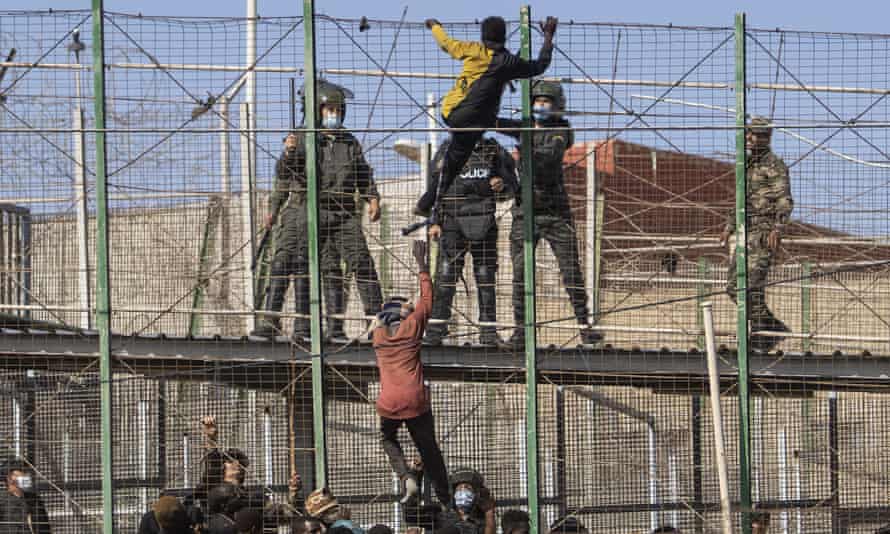18 people were killed after a mass attempt by a large crowd of African migrants to cross it Morocco In the Spanish enclave of Melilla.
The local delegation of the Spanish government said in a statement that about 2,000 migrants approached Melilla at dawn on Friday, and more than 500 managed to enter the border control area after cutting a fence with shears.
Moroccan officials said late on Friday that 13 migrants died of their injuries sustained in the incursion, in addition to five who were confirmed dead earlier today.
“Some of them fell from the top of the barrier” separating the two sides, a Moroccan official said, adding that 140 security personnel and 76 migrants were wounded during the attempt to cross.
This was the first such mass incursion since then Spain Morocco repaired diplomatic relations last month.
The local delegation of the Spanish government said that 49 members of the Spanish police were slightly injured.
Morocco had deployed a “significant” number of troops in an attempt to repel the attack on the border and it had “actively cooperated” with Spanish security forces, earlier said in a statement.
Pictures published by Spanish media showed exhausted migrants lying on the sidewalk in Melilla, some with blood and torn clothes.
Speaking in Brussels, Spain’s prime minister, Pedro Sanchez, condemned the “violent assault”, which he blamed on “the human trafficking mafia”.
Melilla and Ceuta, another small Spanish enclave in North Africa, have the European Union’s only land border with Africa, making them a magnet for migrants.
Omar Naji of the Moroccan human rights organization AMDH said that migrants and security forces “clashed” on Thursday night on the Moroccan side of the border. He added that many of them were taken to hospital in Nador.

In March of this year, Spain ended a year-long diplomatic crisis by backing Morocco’s plan for autonomy for Western Sahara, retreating to its decades-long neutral stance.
Sanchez then visited Rabat and the two governments hailed a “new phase” in relations.
The spat began when Madrid allowed Ibrahim Ghali, the leader of the Polisario Front in Western Sahara, to be treated for COVID-19 in a Spanish hospital in April 2021.
A month later, some 10,000 migrants rushed across the Moroccan border into the Spanish enclave of Ceuta while border guards looked the other way, in what Rabat was widely seen as a punitive gesture.
Rabat calls for Western Sahara to have an independent status under Moroccan sovereignty, but the Polisario wants a UN-supervised referendum for self-determination as agreed in the 1991 cease-fire agreement.
In the days immediately before the correction of relations between Morocco and Spain, there were several attempts at a mass transit of migrants into Melilla, including one involving 2,500 people, the largest such attempt ever. Nearly 500 managed to cross.
Repairing relations with Morocco – the departure point for many immigrants – has led to a decrease in arrivals, particularly in the Spanish Atlantic Canary Islands.
Government figures show that the number of migrants arriving in the Canary Islands in April was 70% lower than in February.
Sanchez warned earlier this month that “Spain will not tolerate any use of the tragedy of illegal immigration as leverage”.
Spain will seek to include “irregular immigration” as one of the security threats to NATO’s southern flank when the alliance meets for a summit in Madrid on June 29-30.
Over the years, thousands of migrants have attempted to cross the 12-kilometre (7.5-mile) border between Melilla and Morocco, or the 8-kilometre border of Ceuta, by climbing fences, swimming along the coast, or hiding in vehicles.
Both areas are protected by fences fortified with barbed wire, video cameras and watchtowers.
Migrants sometimes use hooks and sticks to try to climb the border fence and throw stones at police.




/cdn.vox-cdn.com/uploads/chorus_asset/file/25550621/voultar_snes2.jpg)

More Stories
Two children killed, 11 injured in stabbing attack at Taylor Swift dance party in UK, 17-year-old arrested
Fiber optic communications networks are being sabotaged – DW – 07/29/2024
Putin warns US against deploying long-range missiles in Germany | NATO